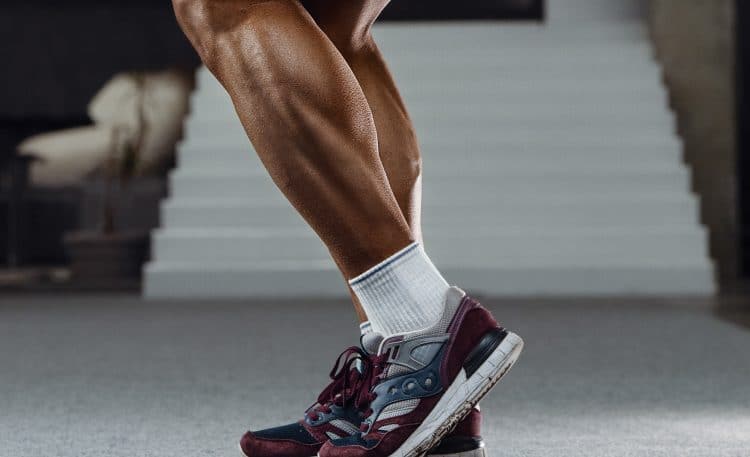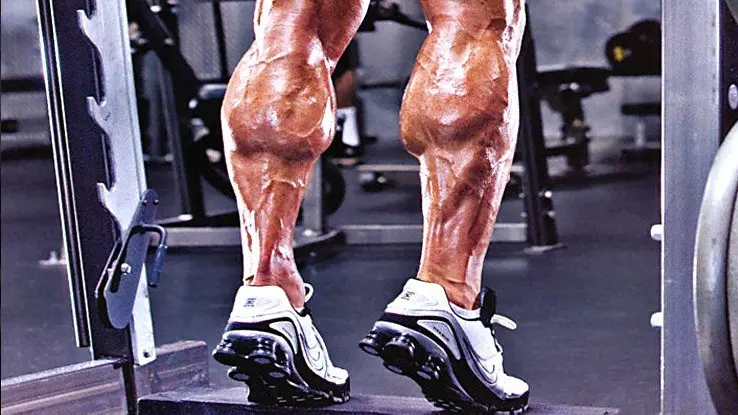Calves are one of the most stubborn muscle groups. Many people find it hard to make them grow, irrespective of how hard or often they train them in the gym.
Are big calves only for improving your physique aesthetics? Not really.
A study conducted on 6,265 people found that the bigger a person’s calves, the smaller their risk of stroke. Regardless of age, sex, body mass index, and other vascular risk factors, those with bigger calves had fewer fatty deposits known as plaques built up in their arteries. It means they have a lower risk for stenosis, carotid artery disease, and strokes. [1]
If you do not wear shorts to the gym as you fear ridicule because of your tiny calves, you have come to the right place. In this article, you’ll learn about the average calf size for men and women of different ages, how to measure your calf circumference correctly, and how to increase your calf size.
What is the average calf size for a man?
You’ve probably heard of the unwritten rules — you should never ask a woman her age, a man his salary, and a gym bro his calf size. Okay, we just came up with the calf size part, but make no mistake, it can be even more offending than the first two questions.

Your calf size is determined by your genetics and daily activity levels, especially if you’re not a gym regular. You could alter your calf circumference with calf exercises, but it requires hard work in the gym.
Level Up Your Fitness: Join our 💪 strong community in Fitness Volt Newsletter. Get daily inspiration, expert-backed workouts, nutrition tips, the latest in strength sports, and the support you need to reach your goals. Subscribe for free!
According to data based on a sample of 4,303 men aged 20 years and above, the Center for Disease Control and Prevention (CDC) suggests that the average male calf size is 15.5 inches. [2]
On average, men between 20 and 29 had 15.5-inch calves, while men aged 30 to 39 had 15.6-inch calves. Average male calf circumference peaks at 15.8 inches for the 40 to 49 age group.
Although men undergo a gradual increase in calf size up to the age of 49, the drop in calf circumference is comparatively drastic. Per the survey, men between 50 and 59 have 15.6-inch calves. It drops down to 15.4 inches by the time they enter their 60s.
In their 70s, men, on average, have 14.9-inch calves, which further drops to 14.2 inches by the time they are in their 80s.
| Age | Average Calf Size |
| 20-29 | 15.5 |
| 30-39 | 15.6 |
| 40-49 | 15.8 |
| 50-59 | 15.6 |
| 60-69 | 15.4 |
| 70-79 | 14.9 |
| 80+ | 14.2 |
Related: Ronnie Coleman Hits Calf Raises for Reps: “Trying My Very Best with My Feet Totally Numb”
What is the average calf size for a woman?
Per the same CDC research cited above (based on the sample size of 4,133 women aged 20 and above), the average female calf size is 15 inches. [2]

For women between the ages of 20 to 29, the average calf size is 14.8 inches. It increases to 15.2 inches for women between 30 and 39 before peaking at 15.4 inches for females aged between 40 and 49.
After peaking around 50, women’s calf size, on average, decreases to 15.1 inches between the age of 60 and 69. The calf size drops to 14.4 inches as women enter their 70s and hits its low at 13.9 inches in their 80s.
| Age | Average Calf Size |
| 20-29 | 14.8 |
| 30-39 | 15.2 |
| 40-49 | 15.4 |
| 50-59 | 15.2 |
| 60-69 | 15.1 |
| 70-79 | 14.4 |
| 80+ | 13.9 |
Although men have larger calves than their counterparts of the same age, the difference isn’t as big as some might have imagined. Notably, age plays an important role in determining your calf size.
Related: The 13 Best Calf Raise Machine Alternatives for Bigger, Stronger Lower Legs
How to Measure Your Calf Size
There are a few different ways of measuring your calf size. Some people like to get their calves measured while seated, while others prefer doing it standing. Calf measurements taken seated are usually bigger than those recorded standing up.
Like in the case of other muscle groups like the biceps and chest, many people like to get their calves measured after they have a good muscle pump from performing a few sets of the lower leg exercises.
Nonetheless, it does not matter if you choose to get your calves measured standing or seated, with or without a pump, or contracted or relaxed. Make sure you do it in the same position every time for consistency.
Here is how to measure your calves correctly:
- Plant your foot flat on the floor while seated or standing.
- If you want to measure your calves in the contracted position, flex your calf by raising your heel off the floor.
- Wrap a tape measure around the thickest part of your calf, usually in the center.
- Record the measurement.
- Do the same for your other calf.
Average Calf Size for Bodybuilding
Competitive bodybuilding is a game of aesthetics, symmetry, and illusions. You do not have to build your calves to a certain size to be able to win bodybuilding shows. However, you should focus on building proportions and balance.
Arnold Schwarzenegger summed it up the best when he said —
“When I went to train with my hero, Reg Park, he pulled out a tape measure and measured my calves and biceps. He said, ‘Arnold, your calves are 19 inches, and your biceps are 21 inches. You might win Mr. Universe like this, but you’ll never go all the way. You need to build up your calves. Every step you take is a 250-pound calf raise. So to grow, you are going to have to go as heavy as possible, and you’re going to need to do 10-15 sets every single day.'”
If you are a bodybuilding fan, make sure your calves are as big as your biceps. If your upper arms are bigger than your lower legs, your body might appear disproportionate.
Check Out: 14 Best Legs in Bodybuilding History
How to Increase Your Calf Size?
Building bigger calves is easier said than done. You’ll have to undergo strict training, diet, and recovery regimen to put muscle mass on your lower legs. Here is an effective calf training workout you should try the next time you hit the gym:
- Donkey Calf Raise: 3 Sets 20 Reps (5:2:5:2)
- Seated Calf Raise: 2 Sets 40, 30 Reps (no tempo), 2 Sets 20 Reps (5:5:5:5)
- Single-Leg Leg-Press Machine Calf Press: 4 Sets 10 Reps (5:2:5:2)
- Standing Calf Raise: 5 Sets 50, 40, 30, 40, 50 Reps
Next Read: 15 Ways To Turn Your Calves Into Full Grown Bulls
FAQs
My calves are a little bigger or smaller for my age. Is it normal?
If your calves are slightly over or under (up to 0.3 inches, either way) the average size for your age and gender, your calves will still be considered normal. However, if your calves are smaller, you should follow the workout listed above to add mass to your lower legs.
What size calves are considered big?
For men of average height (five-foot-nine) and weight (194.7 pounds), 16-inch calves or bigger can be considered big. On the other hand, 15.5-inch or bigger calves can be considered big for women of average height (five-foot-four) and weight (170.6 pounds). [2]
Conclusion
Knowing the average calf size for your age and gender gives you a good idea of where you stand in terms of your lower leg gains.
If you want to add size to your calves, you should add the workout mentioned above to your training regimen and follow a high-protein diet. On the other hand, you should switch to a calorie-deficit diet and spike your cardiovascular workouts to lose a few inches off your lower legs.
References
- Debette S, Leone N, Courbon D, Gariépy J, Tzourio C, Dartigues JF, Ritchie K, Alpérovitch A, Ducimetière P, Amouyel P, Zureik M. Calf circumference is inversely associated with carotid plaques. Stroke. 2008 Nov;39(11):2958-65. doi: 10.1161/STROKEAHA.108.520106. Epub 2008 Aug 14. PMID: 18703804.
- McDowell MA, Fryar CD, Ogden CL, Flegal KM. Anthropometric reference data for children and adults: United States, 2003–2006. National health statistics reports; no 10. Hyattsville, MD: National Center for Health Statistics. 2008.









